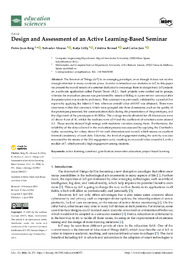Please use this identifier to cite or link to this item:
https://hdl.handle.net/11000/35332Full metadata record
| DC Field | Value | Language |
|---|---|---|
| dc.contributor.author | Roig, Pedro Juan | - |
| dc.contributor.author | Alcaraz, Salvador | - |
| dc.contributor.author | Gilly, Katja | - |
| dc.contributor.author | Bernad, Cristina | - |
| dc.contributor.author | Juiz, Carlos | - |
| dc.contributor.other | Departamentos de la UMH::Ingeniería de Computadores | es_ES |
| dc.date.accessioned | 2025-01-26T15:49:48Z | - |
| dc.date.available | 2025-01-26T15:49:48Z | - |
| dc.date.created | 2024 | - |
| dc.identifier.citation | Education Sciences | es_ES |
| dc.identifier.issn | 2227-7102 | - |
| dc.identifier.uri | https://hdl.handle.net/11000/35332 | - |
| dc.description.abstract | The Internet of Things (IoT) is an emerging paradigm, even though it does not receive enough attention in many academic plans. In order to introduce our students to IoT, in this paper we present the overall results of a seminar dedicated to encourage them to design basic IoT projects on a software application called Packet Tracer v8.2.1. Such projects were carried out in groups, whereas the evaluation process was performed by means of filling in a peer review construct after the presentation was made by each team. This construct was previously validated by a panel of five experts by applying the Aiken’s V test, where an overall value of 0.907 was obtained. There were nine items within that construct, which were grouped into three dimensions, such as the quality of the prototypes presented, the communication skills during the presentations of the prototypes, and the alignment of the prototypes with SDGs. The average results obtained for all dimensions were all above 8 out of 10, whilst the medians were all 9 and the coefficient of variations were around 0.2. Those results showed high ratings with moderate variation among them. Furthermore, the reliability of the data collected in the evaluation process was assessed by applying the Cronbach’s alpha, accounting for values above 0.9 for each dimension and overall, which means an excellent internal consistency of such data. Likewise, the level of engagement during the activity was also measured by the means of the ISA engagement scale, resulting in an overall value around 6.5, with a median of 7, which proved a high engagement among students. | es_ES |
| dc.format | application/pdf | es_ES |
| dc.format.extent | 19 | es_ES |
| dc.language.iso | eng | es_ES |
| dc.publisher | MDPI | es_ES |
| dc.relation.ispartofseries | 14 | es_ES |
| dc.relation.ispartofseries | 4 | es_ES |
| dc.rights | info:eu-repo/semantics/openAccess | es_ES |
| dc.rights | Attribution-NonCommercial-NoDerivatives 4.0 Internacional | * |
| dc.rights.uri | http://creativecommons.org/licenses/by-nc-nd/4.0/ | * |
| dc.subject | active learning | es_ES |
| dc.subject | construct | es_ES |
| dc.subject | gamification | es_ES |
| dc.subject | innovative education | es_ES |
| dc.subject | project-based learning | es_ES |
| dc.subject.other | CDU::0 - Generalidades.::04 - Ciencia y tecnología de los ordenadores. Informática. | es_ES |
| dc.title | Design and Assessment of an Active Learning-Based Seminar | es_ES |
| dc.type | info:eu-repo/semantics/article | es_ES |
| dc.relation.publisherversion | https://doi.org/10.3390/educsci14040371 | es_ES |

View/Open:
Design and Assessment of an Active Learning-Based Seminar.pdf
293,81 kB
Adobe PDF
Share:
.png)
